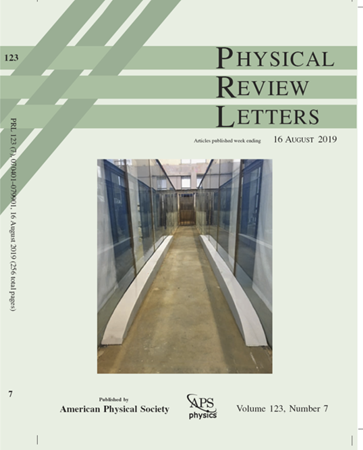Dynamical Formation of Regular Black Holes
IF 8.1
1区 物理与天体物理
Q1 PHYSICS, MULTIDISCIPLINARY
引用次数: 0
Abstract
We study dynamical gravitational collapse in a theory with an infinite tower of higher-derivative corrections to the Einstein-Hilbert action and we show that, under very general conditions, it leads to the formation of regular black holes. Our results are facilitated by the use of a class of theories that possess second-order equations on spherically symmetric metrics, but which are general enough to provide a basis for the gravitational effective action in any D≥5. We analytically solve the collapse of a thin shell of dust and show that it inevitably experiences a bounce at small radius and that its motion can be extended to arbitrary proper time. The collapse of the shell always gives rise to a singularity-free, geodesically complete spacetime that contains horizons if the total mass is above a critical value. In that case, the shell bounces into a new universe through a white hole explosion. Our construction provides, to the best of our knowledge, the first fully dynamical description of formation of regular black holes, and it suggests that higher-derivative corrections may be the most natural way to resolve the singularities of Einstein’s theory.规则黑洞的动力形成
我们在一个理论中研究了动态引力坍缩,该理论对爱因斯坦-希尔伯特作用有无限高导数修正,我们表明,在非常一般的条件下,它会导致规则黑洞的形成。我们的结果通过使用一类具有球对称度量的二阶方程的理论得到了简化,但这些理论足够普遍,可以为任何D≥5的引力有效作用提供基础。我们解析解了薄壳尘埃的坍缩,证明了薄壳尘埃在小半径处不可避免地会发生弹跳,其运动可以扩展到任意固有时。如果总质量高于一个临界值,那么壳层的坍缩总是会产生一个无奇点的、测地线完备的时空,它包含视界。在这种情况下,壳通过白洞爆炸弹回一个新的宇宙。据我们所知,我们的构造提供了第一个对规则黑洞形成的完全动力学描述,它表明,高导数修正可能是解决爱因斯坦理论奇点的最自然方法。2025年由美国物理学会出版
本文章由计算机程序翻译,如有差异,请以英文原文为准。
求助全文
约1分钟内获得全文
求助全文
来源期刊

Physical review letters
物理-物理:综合
CiteScore
16.50
自引率
7.00%
发文量
2673
审稿时长
2.2 months
期刊介绍:
Physical review letters(PRL)covers the full range of applied, fundamental, and interdisciplinary physics research topics:
General physics, including statistical and quantum mechanics and quantum information
Gravitation, astrophysics, and cosmology
Elementary particles and fields
Nuclear physics
Atomic, molecular, and optical physics
Nonlinear dynamics, fluid dynamics, and classical optics
Plasma and beam physics
Condensed matter and materials physics
Polymers, soft matter, biological, climate and interdisciplinary physics, including networks
 求助内容:
求助内容: 应助结果提醒方式:
应助结果提醒方式:


